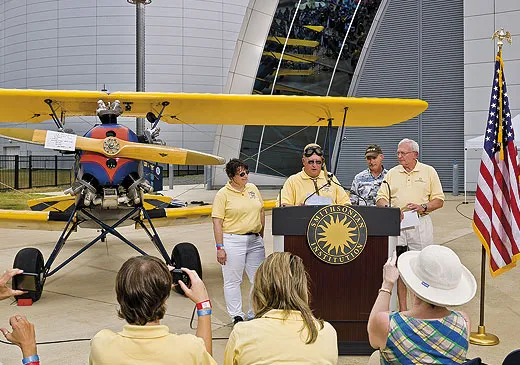In the Museum: A Fleet’s Final Flight
A civilian flight trainer enters the collections.
/https://tf-cmsv2-smithsonianmag-media.s3.amazonaws.com/filer/In_The_Museum_0911_1_FLASH.jpg)
When Gene Breiner first saw the Fleet Model 2, it was languishing at the Blue Swan Airport in Bradford County, Pennsylvania, in 1952. “It was sitting in a Quonset hut,” he recalls, “and the fabric was all off the fuselage. No wings, no tail—just the engine, sitting on its gear. So I asked if it was for sale.” The owner told him no; the airplane was going to be rebuilt.
At the time, Breiner was doing airplane repairs at a little grass airport in Danville, Pennsylvania; he spent his winters rebuilding derelict airplanes to resell in the spring.
In 1963, Breiner joined the Federal Aviation Agency and moved to Richmond, Virginia. But by 1969, he had transferred back to the Harrisburg area as an FAA inspector, and one of the airfields on his route was the Blue Swan.
“I went to the airport one day,” he says, “and lo and behold, there the Fleet sat, in the same spot as in 1952.” He offered again to buy it, and was again turned down.
In 1978, the Fleet’s owner died, and the family finally offered Breiner the aircraft. “I said, ‘Well, fine. That’s good.... But where’s the rest of it?’ ”
The wings were hanging in a barn in Wyalusing; an aileron, struts, and part of the stabilizer were in a garage a few miles away. Other parts were thrown into boxes all over northeastern Pennsylvania. “I just photographed boxes of parts because I didn’t have time to inventory them,” says Breiner.
When he developed the film, Breiner realized he had located close to 90 percent of the Fleet. So he bought the remains, as well as replacement parts for what was missing, and spent the next seven years restoring the aircraft he would name Plane Jane to airworthy status.
This past June, at the National Air and Space Museum’s Become a Pilot Day, Breiner donated the Fleet—one of only six surviving Model 2s—to the Museum.
“The aircraft is unique because it was designed to be a civilian trainer from the beginning,” says aeronautics curator Dorothy Cochrane. “In 1928, when Reuben Fleet designed the aircraft, there was a boom in aviation following Charles Lindbergh’s nonstop, solo flight across the Atlantic. And Fleet was trying to latch on to that.”
Fleet knew his market. “In the spring and summer of 1929,” says Breiner, “the Fleet Aircraft Company was turning out airplanes like pancakes.” The company built more than 300 Model 2s that year, selling them to flight schools across the country.
Six Fleets—including Breiner’s—were sold to the Roosevelt Field aviation school on Long Island, New York. There the airplane was flown by hundreds of students, among them Zack Mosley, creator of the comic strip “Smilin’ Jack.”
Plane Jane was owned by Roosevelt Field until 1942, when all private civilian flight training was prohibited east of the Susquehanna River. From 1942 to 1945, Aircraft Services Consolidated in Bloomsburg, Pennsylvania, flew it under the government’s Civilian Pilot Training Program.
“I always liked biplanes,” says Breiner. “Two wings seem a lot more sensible. It’s a stable airplane, an ideal training aircraft.”
The Fleet is not without its quirks. “It’s a ground-looper,” says Breiner. “When you fly a Fleet, you’re only one of two persons: You either have or you haven’t ground-looped. I joined the group that has.”
The aircraft is also noisy, sort of a flying John Deere tractor. Breiner made good use of that quality at the Sentimental Journey Fly-in in Lock Haven, Pennsylvania, which he attended 25 years in a row. “I’d get up early in the morning, before sunrise, and wipe away the dew,” he recalls. “I’d taxi down that runway, and I’d wait until the sun would just break over the horizon. And I’d take off in the stillness of the morning and fly over the campground and wake everybody up.”
Within a year from the date it was donated, Plane Jane will go on display at the Steven F. Udvar-Hazy Center in northern Virginia, where it will have pride of place as the sole aircraft of the Civilian Pilot Training Program in the Museum’s collection.
